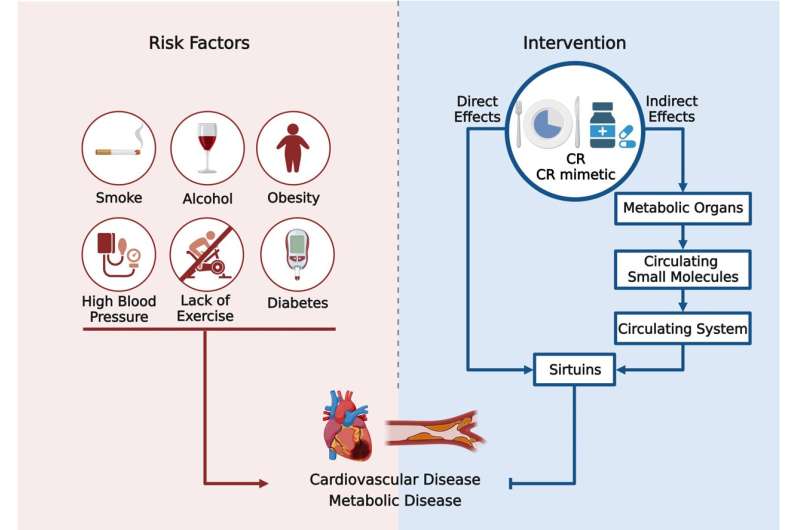This article has been reviewed according to Science X's editorial process and policies. Editors have highlighted the following attributes while ensuring the content's credibility:
fact-checked
proofread
Review highlights beneficial interplay between caloric restriction, sirtuins and cardiovascular diseases

Cardiovascular disease (CVD) refers to a group of disorders affecting the heart and blood vessels and is a leading cause of death globally. Lifestyle factors have been linked to the incidence of CVD and the inclusion of an active, healthy lifestyle along with other therapeutic interventions may help combat CVD.
In recent years, emerging research into caloric restriction (CR), dietary therapy, and its role in improving cardiovascular health has gained a lot of attention. CR involves creating a calorie or energy deficit by reducing the intake of food while simultaneously maintaining appropriate levels of vital minerals and supplements.
Against this backdrop, a team of researchers led by Dr. DePei Liu and Dr. HouZao Chen, from the Chinese Academy of Medical Sciences and Peking Union Medical College, China sought to understand the underlying mechanisms between CR and CVD. They hypothesized the role of sirtuins in regulating the beneficial effects of CR.
Sirtuins are proteins that regulate cellular metabolism and stress response by acting as energy sensors. The researchers in their quest to determine the beneficial interplay between CR and sirtuins have now performed a comprehensive review of the research literature and have published their findings in the Chinese Medical Journal on 25 March 2024. The researchers outline two possible mechanistic pathways that contribute to the overall function of sirtuins.
The researchers assessed the potential benefits of CR by its direct contributions to overall heart and vascular health. By analyzing the energy utilization within heart tissue, they reported the increased consumption of fats during CR, leading to better lipid metabolism. CR altered metabolic pathways and exerted a positive influence on different cardiac conditions, such as cardiac hypertrophy, heart failure, and post-ischemic myocardial injury.
Elaborating on the benefits of CR, the corresponding author of the review article, Dr. Liu says, "CR has been demonstrated to promote vascular health and alleviate vascular aging by affecting systemic risk factors and modulating the microenvironment of the vascular wall, including endothelial and smooth muscle cells. The combination of reduced inflammation, improved lipid and glucose metabolism, enhanced nitric oxide bioavailability, regulation of proliferation, autophagy and age-related endothelial progenitor cell dysfunction underpins the beneficial effects."
Further, the team investigated the role of sirtuin proteins, particularly SIRT1 as an epigenetic regulator. They suggest that CR regulates metabolic processes via the low energy status which increases the intracellular levels of NAD+. Increased levels of NAD+ activate SIRT1, which, in turn, modulates several other molecular signaling pathways, ultimately resulting in cardio-protective effects.
They note that CR also exerts considerable impact on the liver, adipose tissue, and skeletal muscles, leading to the production of specific small molecules. These small molecules such as gasotransmitters and non-coding RNAs, and small molecule metabolites regulate sirtuin activity and improve cardiovascular health.
Reflecting on future research prospects, Dr. Chen concludes, "The existing studies on sirtuins and CR represent merely the tip of the iceberg. The evidence supporting sirtuin as the sensor or mediator of CR is still insufficient, and the distinct functions of each molecule within the family have not been clearly analyzed."
With any luck, the design and development of novel CR mimetics could result in innovative therapeutic approaches for the management of CVD.
More information: Ziyu Wei et al, Caloric restriction, Sirtuins, and cardiovascular diseases, Chinese Medical Journal (2024). DOI: 10.1097/CM9.0000000000003056





















